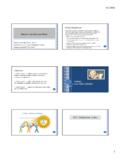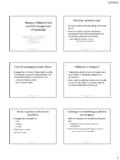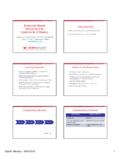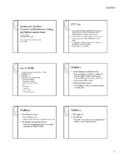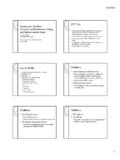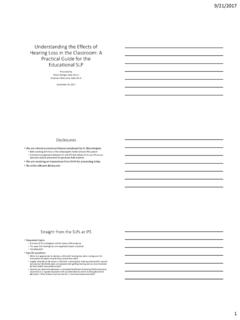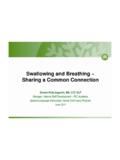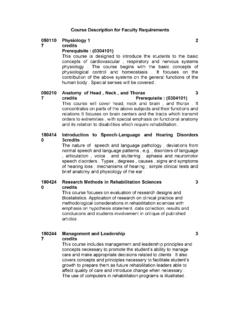Transcription of Individualized Dysphagia Plan: Using Evidence to …
1 Individualized Dysphagia plan : Using Evidence to Develop a Unique plan for your Patient Dawn Wetzel MAT,CCC-SLP Clinical Associate Professor Purdue University Indiana Speech-Language Hearing Association Wetzel, ISHA 2014 1 Disclosure Financial: I receive a salary from Purdue University. I occasionally provide prn services for Arnett Hospital for which I am compensated. I will receive an honorarium for this presentation. Non-Financial: None Wetzel, ISHA 2014 2 Wetzel, ISHA 2014 3 Wetzel, ISHA 2014 4 Wetzel, ISHA 2014 5 Wetzel, ISHA 2014 6 Wetzel, ISHA 2014 7 Goals for this presentation Review current Evidence as it applies to the continuum of care in the evaluation and treatment of Dysphagia Include some anecdotal spice from an old/seasoned clinician Encourage conversation regarding incorporation of Evidence into current practice patterns Wetzel, ISHA 2014 8 Clinical Swallowing Evaluation What is our goal?
2 What must be included and why? Wetzel, ISHA 2014 9 What Is Our Goal? Screen Identify Dysphagia Identify aspiration Determine etiology of Dysphagia and direction of treatment Determine when to do instrumental assessment Wetzel, ISHA 2014 10 Screening James L. Coyle, , CCC-SLP, BRS-S ASHA, 2013 Seeks to rule out signs of a disorder Determines whether more testing is needed Uses ONE sign (positive, negative) Generates a PASS-FAIL result Does NOT identify source/cause of the FAILED screen Does NOT generate justifications for treatment Wetzel, ISHA 2014 11 Screening Examples of Medical Screening Glucose/blood sugar Mammography Blood pressure Colonoscopy Wetzel, ISHA 2014 12 Screening James L.
3 Coyle, , CCC-SLP, BRS-S ASHA, 2013 Parallel screening We have 2 (or more) tests If patient fails either, we do not do the second test Patient is referred for diagnostic test or is treated Series screening We have 2 (or more) tests Patient must fail both tests to be referred for diagnostic test or be treated. Wetzel, ISHA 2014 13 Purpose of Dysphagia Screening To determine the likelihood that aspiration is present The need for formal swallow evaluation When it is safe to recommend resumption of oral alimentation. Wetzel, ISHA 2014 14 MGH Nursing Screen Patient Readiness Wetzel, ISHA 2014 15 Wakefulness HOB elevated Stable O2 stats Oral care Remain NPO & Re-screen Proceed to part 2 Part 1 Ye s No MGH Nursing Screen Clinical Screening Wetzel, ISHA 2014 16 Part 2 Tongue movement Volitional Cough Swallow water Pharyngeal sensation Vocal quality Each worth 1 point except swallow = 2.
4 Pass = 5-6/Fail = < 4 MGH-SST When compared to FEES, the MGH-SST performed similarly among the entire study population and stroke subset. Sensitivity was and respectively Specificity was and respectively (Goldsmith et al., 2008; Goldsmith, Cohen, Vega-Barachowitz & Nalipinski, 2007) Wetzel, ISHA 2014 17 The Three Ounce Water Test DePippo, Holas, and Reding, 1992 Identified 80% of patients aspirating (16/20) Sensitivity 76%; Specificity 59% Identified patients with more severe Dysphagia and aspirating larger amounts Sensitivity 94%; Specificity 26% Identified patients aspirating thicker viscosities Sensitivity 94%; Specificity 30% Wetzel, ISHA 2014 18 Clinical Utility of the 3 oz.
5 Water Te s t (Suiter and Leder, 2008) Does the 3-ounce water swallow test identify individuals who aspirate thin liquids? Does a failed 3-ounce water swallow test identify individuals who are also unsafe for oral alimentation based on results of an instrumental swallow assessment? Does a successfully passed 3-ounce water swallow test permit specific diet recommendations to be made without further objective swallow assessment? Wetzel, ISHA 2014 19 Clinical Utility of the 3 oz. Water Te s t (Suiter and Leder, 2008) To determine presence of aspiration in 3000 patients 38% passed 62% failed Sensitivity Specificity = False positive rate = Wetzel, ISHA 2014 20 Clinical Utility of the 3 oz.
6 Water Te s t (Suiter and Leder, 2008) To determine safety of PO diet Sensitivity for safe for oral intake Specificity False positive rate Wetzel, ISHA 2014 21 Author s Conclusions Failure does not indicate inability to tolerate thin liquids Unnecessarily restricts liquid intake for nearly half of the patients tested Over-referral for formal swallowing assessment If passed, diet recommendations can be made without additional testing-need to consider other variables though Wetzel, ISHA 2014 22 Questions Was there bias in determination of diet due to fact FEES was completed first?
7 Are milk and water comparable? What percentage coughed/couldn t do/had vocal quality changes? What about treatment? What is the definition of tolerates diet? Were the patients followed for a period of time? Wetzel, ISHA 2014 23 Safe Initiation of Oral Diets in Hospitalized Patients Based on Passing a 3-ounce (90 cc) Water Swallow Challenge Protocol. Had to pass 3-ounce water swallow challenge for inclusion disqualified 12 24 h after passing a 3-ounce challenge protocol study patients were drinking thin liquids and eating food successfully and safely Fluid intake: 240-460 ml Food intake: 10-100% (Leder et al, 2012) Wetzel, ISHA 2014 24 3-ounce water swallow challenge protocol Additional factors to consider and to assess prior to utilizing.
8 Pre-morbid feeding status and ability cognitive status cooperativeness and level of consciousness gross oral motor functioning respiratory muscle function and endurance posture limitations Wetzel, ISHA 2014 25 Clinical Swallowing Evaluation Identify Dysphagia Identify aspiration Determine etiology of Dysphagia and direction of treatment Determine when to do instrumental assessment Wetzel, ISHA 2014 26 Clinical Swallowing Evaluation McCullough et al, 1999 History Oral mech Voice Presentation of boluses Wetzel et Wetzel Adjunct tools Cervical auscultation Palpation Oximetry Wetzel, ISHA 2014 27 History Reliability of reporting Have an established history form Include information supported by the literature Utilize a consistent standardized inventory to rate the severity of Dysphagia Wetzel.
9 ISHA 2014 28 History Outcome Scales FOIS Ordinal scale that rates the oral intake of the patient with Dysphagia 7 levels ranging from NPO to full oral diet with no restrictions NOMS Ordinal scale 7 levels ranging from NPO full oral diet Includes use of strategies and degree of cueing needed Corresponds with G-codes Wetzel, ISHA 2014 29 History Outcome Scales Symptom reporting E AT-10 10 item survey Rate symptom from 0-4 Score > 3 abnormal Sydney Swallow Questionnaire Self-report symptom inventory 17 item survey- Max score 1700 Visual analog scale Wetzel, ISHA 2014 30 History Outcome Scales Patient perceptions SWAL-QOL Assesses impact on QOL Frequently cited in research 4 choices 10th grade reading level Limited accessibility Wetzel.
10 ISHA 2014 31 History Outcome Scales MDADI Self-administered questionnaire designed specifically for evaluating the impact of Dysphagia on the QOL of patients with head and neck cancer 20 items 10 minute administration Wetzel, ISHA 2014 32 Dysphagia Handicap Index Validated, reliable tool assessing psychosocial handicapping effects of Dysphagia Physical Emotional Functional Twenty five items. Limited to 3 choices Never Sometimes Always 7 point scale rating perception of Dysphagia severity Wetzel, ISHA 2014 33 Items Rated As Important and Frequently Used by Clinicians McCullough et al, 1999 History Research Support No Research Hx of pneumonia Patient report Type of neurologic insult Family report Nutritional status GI anomaly Structure Previous surgery Other diseases Medications Wetzel.
